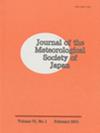星载双频降水雷达观测全球雨滴大小分布的4年气候学及其季节变化
IF 1.6
4区 地球科学
Q3 METEOROLOGY & ATMOSPHERIC SCIENCES
引用次数: 17
摘要
本研究利用全球降水测量(GPM)核心天文台的双频降水雷达(DPR)研究了降雨的全球落差大小分布及其与大尺度降水特征的关系。本研究的重点是关于DSD变化的主要降水系统的季节变化。基于从GPM/DPR导出的双频信息估计的质量加权平均直径(Dm)被统计分析为DSD的典型参数。一般来说,陆地上的年平均Dm值大于海洋上的,Dm和降水率(R)之间的关系不是简单的一对一关系。此外,Dm表现出统计上显著的季节变化,特别是在西北太平洋,而R表现出不显著的变化,表明R的变化不能解释Dm的明显季节变化,结果表明,Dm的变化与主要降水系统的季节变化有关。在西北太平洋的夏季,Dm与中纬度地区与Baiu锋有关的有组织降水系统和副热带地区的热带扰动有关,这些系统的降水顶部高度相对较高,由层状降水和对流降水组成。与夏季相反,冬季中纬度地区较大的Dm与温带有关。通讯作者:Moeka Yamaji,日本宇宙航空研究开发机构地球观测研究中心,2-1-1 Sengen,Tsukuba,Ibaraki,305-8505,日本电子邮件:yamaji.moeka@jaxa.jpJ阶段进展发表日期:2020年5月27日日本气象学会杂志第98卷第4 756期本文章由计算机程序翻译,如有差异,请以英文原文为准。
4-year Climatology of Global Drop Size Distribution and its Seasonal Variability Observed by Spaceborne Dual-frequency Precipitation Radar
This study investigates the global drop size distribution (DSD) of rainfall and its relationship to large-scale precipitation characteristics using the Dual-frequency Precipitation Radar (DPR) onboard the Global Precipitation Measurement (GPM) Core Observatory. This study focuses on seasonal variations in the dominant precipitation systems regarding variations in DSD. A mass-weighted mean diameter (Dm), which is estimated based on the dualfrequency information derived from the GPM/DPR, is statistically analyzed as a typical parameter of the DSD. Values of the annual mean Dm, in general, are larger over land than over the oceans, and the relationship between Dm and precipitation rate (R) is not a simple one-to-one relationship. Furthermore, Dm exhibits statistically significant seasonal variations, specifically over the northwest Pacific Ocean, whereas R shows insignificant variations, indicating the variations in R cannot explain the distinct seasonal changes in Dm. Focusing on the seasonal variation in Dm over the northwest Pacific Ocean, the results indicate that the variation in Dm is related to the seasonal change in the dominant precipitation systems. In the summer over the northwest Pacific Ocean, Dm is related to the organized precipitation systems associated with the Baiu front over the mid-latitudes and tropical disturbances over the subtropical region, with relatively higher precipitation top heights, composed of both stratiform and convective precipitations. Contrary to the summer, larger Dm over the mid-latitudes in winter is related to extraCorresponding author: Moeka Yamaji, Earth Observation Research Center, Japan Aerospace Exploration Agency, 2-1-1 Sengen, Tsukuba, Ibaraki, 305-8505, Japan E-mail: yamaji.moeka@jaxa.jp J-stage Advance Published Date: 27 May 2020 Journal of the Meteorological Society of Japan Vol. 98, No. 4 756
求助全文
通过发布文献求助,成功后即可免费获取论文全文。
去求助
来源期刊
CiteScore
6.70
自引率
16.10%
发文量
56
审稿时长
3 months
期刊介绍:
JMSJ publishes Articles and Notes and Correspondence that report novel scientific discoveries or technical developments that advance understanding in meteorology and related sciences. The journal’s broad scope includes meteorological observations, modeling, data assimilation, analyses, global and regional climate research, satellite remote sensing, chemistry and transport, and dynamic meteorology including geophysical fluid dynamics. In particular, JMSJ welcomes papers related to Asian monsoons, climate and mesoscale models, and numerical weather forecasts. Insightful and well-structured original Review Articles that describe the advances and challenges in meteorology and related sciences are also welcome.

 求助内容:
求助内容: 应助结果提醒方式:
应助结果提醒方式:


